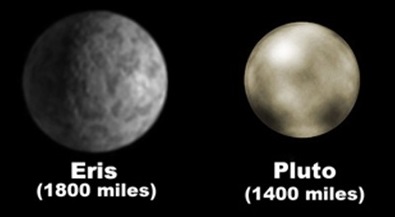

Three times more distant from the Sun than Pluto (almost 10 billion miles), Eris is the largest dwarf planet in the Solar System. It takes Eris more than twice as long to orbit the Sun as Pluto (about 557 years), and because its mass is 27% greater than Pluto’s, scientists initially described the newly discovered Eris as the Solar System’s “tenth planet”.

Eris was first spotted in 2003 at a Mount Palomar Observatory in California, by Mike Brown, a professor of planetary astronomy at the California Institute of Technology; Chad Trujillo of the Gemeni Observatory; and David Rabinowitz of Yale University. The discovery was confirmed in January 2005, and the public announcement was made on July 29, 2005, the same day as Makemake and two days after Haumea, two other recently discovered dwarf planets.
Eris’s discovery was significant, not only because scientists found a large, distant body with a high-eccentricity orbit around the Sun that extends far beyond the Kuiper Belt (a zone of icy debris beyond the orbit of Neptune), but also because its discovery triggered a debate in the scientific community that eventually led to the International Astronomical Union’s decision to clarify the definition of a planet. Scientists were arguing that if Pluto qualified as a planet, then so should Eris. But it was decided on August 24, 2006, that under the IAU (the International Astronomical Union) definition, Eris is a “dwarf planet”, along with Pluto, Ceres, Haumea, and Makemake.
“What’s in a name?”
A lot of time, effort and brain power went into choosing a name for this trans-Neptunian object. After the discovery, it was provisionally designated as 2003 UB313. Then it was nicknamed “Xena” by the discovery team after the television warrior princess, and became known by this name to the wider public. Other names were considered, such as “Lila” (from Hindu mythology) and “Persephone” after the wife of the god Pluto. Because there was already an asteroid with that name, “399 Persephone”, this beautiful name had to be dropped and on September 6, 2006, the discovery team proposed “Eris”. The name was accepted by the IAU as the official name. Mike Brown (the discovery team leader) said that Eris was his favorite Greek goddess and “quite a fun goddess, really!” Read on and see if you agree.
Eris (Ancient Greek god of“Strife”) was a Greek goddess of chaos and discord (her Roman name is “Discord”). According to some sources, she is the daughter of Nyx (Night), but other sources claim that she was the unloved child of Zeus and Hera, and a sister to Ares (Roman “Mars”), the god of war. This is how Bernard Evslin, the author of Gods, Demigods, and Demons, describes her:
“Eris shared many of the characteristics of her twin brother-Ares: riding beside him in his war-chariot, shrieking with glee at the sight of blood. War was her great festival, but she was addicted to strife in any form and ceaselessly fomented it- domestic quarrels, blood feuds, border skirmishes. She was detested by other gods, but they tried to conceal their feelings, because her anger was deadly and she bore a grudge through eternity.”
The most well-known tale of Eris is the one that portrays her as an initiator of the famous Trojan War. This is how it goes:
At the wedding of Peleus and Thetis all the Olympian gods were invited to celebrate, except for Eris. This made Eris furious, but she decided to go to the banquet anyway (with an evil plan, of course). When she arrived, she was refused admittance and, as a parting gift, she cast down a golden apple inscribed with“To the Fairest.” (Does this remind you of the wicked witch from the fairy tale “Sleeping Beauty”?)

As you can imagine, all the beautiful maidens and nymphs and goddesses claimed the apple, but in the end they all withdrew their candidacy, except for Hera, Athena, and Venus. Zeus was asked to settle the dispute but, not wanting to anger any of the goddesses, he appointed a judge who would decide which one of them was the fairest. The judge was Paris, the son of the King of Troy. Each goddess attempted to influence Paris’s vote, promising wisdom and glory, wealth, and power, but Venus promised him only one thing – the most beautiful woman in the world for his wife. And if you remember your Greek mythology, his wife, Helen of Troy, was the reason for the Trojan War and Troy’s subsequent fall.
But before I get back to Eris, I want to give you a list of the names of her children, just for fun: Algea (Pain), Amphillogias (Dispute), Androktasias (Manslaughter), Ate (Blindness), Dysnomia (Lawlessness), Horkos (Oath), Hysminai (Battle), Lethe (Forgetfullness), Limos (Starvation), Logos (Word), Machai (Quarrel), Neikea (Grievance), and Ponos (Hardship). And if you speak Russian, you know that the last one is real double-trouble!
A few words about Eris’s stellar qualities:

Eris’s diameter is estimated to be between 2,400 and 3,00 kilometers (1,490 to 1,860 miles). It has a tiny moon – Dysnomia (the Greek goddess of Lawlessness, daughter of Eris), which orbits the dwarf planet in about 16 days. Observations of Dysnomia’s orbit allowed scientists to determine the mass of Eris, which is greater than Pluto’s. Eris is also substantially denser than Pluto, which suggests that it is composed mostly of rocky materials.
Unlike Pluto, which is somewhat reddish in color, Eris appears almost grey. Observations of Eris reveal the presence of methane ice, indicating that the surface may be similar to that of Pluto. Scientists believe that the surface temperatures on Eris varies from -359 degrees Fahrenheit (-217 degrees Celsius) to -405 degrees Fahrenheit (-234 degrees Celsius).
Eris and its moon are currently the most distant known objects in the Solar System apart from long-period comets and space probes. Let’s hope that the next trans-Neptunian object scientists discover will get a name of a benevolent mythological deity with better adjusted children.